Ixalan Mechanics
Good news, Planeswalker! Your travels have brought you to Ixalan, a world of discovery—lush jungles, gorgeous waterways, and no small amount of treasure. Much of that treasure, not to mention unimaginable power, lies within Orazca, a lost city of gold. In fact, this would be a lovely vacation spot if it weren't for everyone constantly fighting to locate and control Orazca. Don't you worry, though. We're going to review everything you need to know to survive and thrive amidst this perilous paradise.
The Sun Empire (And Their Enraged Dinosaurs!)
The Warriors of the Sun Empire have learned to command terrifying Dinosaurs on the battlefield. Their signature mechanic is enrage, an ability word that encompasses abilities that trigger whenever the Dinosaurs with them are dealt damage. You do not want to make Dinosaurs angry.
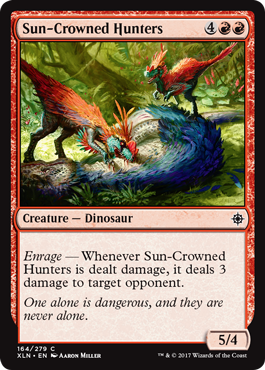
One reliable way to make sure your Dinosaur is dealt damage is to smash it into smaller opposing creatures. For most Dinosaurs, "smaller opposing creatures" is somewhat redundant. But the set also includes a few clever ways to enrage your Dinosaurs at will. Enrage abilities will trigger even if the Dinosaur is dealt lethal damage, but I would not recommend trying this. Dead Dinosaurs smash less often than live ones. In conclusion, RAWR!
The Brazen Coalition (And Their Raiding Pirates!)
If you're a Pirate in the Brazen Coalition, you seek to amass treasure. It's what you do. If you want to save fifteen percent or more on the amount of effort it takes to amass treasure, you attack those who already have it. The raid mechanic rewards ruthless aggression.
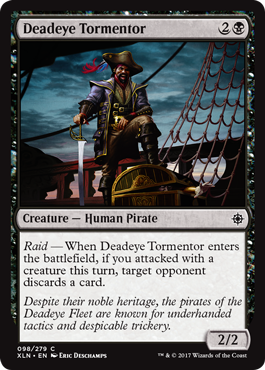
Raid abilities care in some way that you attacked with a creature during your turn. Each one is different; be sure to read each bonus carefully so you know what you're getting. Naturally, it's usually better to cast creatures like Deadeye Tormentor in the postcombat main phase.
Raid abilities don't care about how many creatures you attacked with. If you charged in with four creatures and then cast Deadeye Tormentor after combat, its ability would trigger only once, not four times. Raid abilities also don't care about what happened to the attacking creature. Maybe it survived combat, maybe it didn't. Maybe it got bounced. Maybe it changed controllers (that traitor!). As long as you attacked with it, that's good enough for a raid ability.
You may be thinking, "Hey, attacking is great. Gonna do it a lot. But . . . you said treasure. Where's the treasure?" I'm glad you asked.
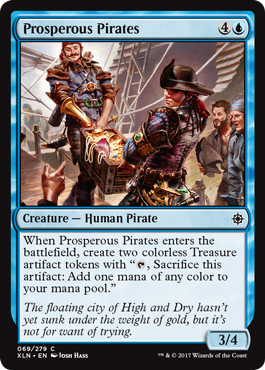
Each Treasure is a colorless artifact that you can "cash in" for one mana of any color by tapping and sacrificing it. Treasure is both the name of the token and its artifact type. Several cards in this set create Treasure tokens, giving you a welcome boost in resources allowing you to pull away from the competition. In conclusion, YARRR!
The River Heralds (And Their Elusive Merfolk!)
The Merfolk strategy revolves around being very difficult to block and growing via +1/+1 counters. They don't have a named keyword, and thus don't have a preview card in this article. If you're a Merfolk fan, don't fret, there are plenty of goodies in store.
The Legion of Dusk (And Their Bloodthirsty Vampires!)
Similar to Merfolk, the Vampires in this set don't have a named keyword. Rather, their strategy revolves around the manipulation of life. If you choose to serve the Legion, you'll find yourself paying life for powerful effects, regaining that life via lifelink and other abilities, and ultimately draining the life from your foes.
Let's Go Exploring!
There's a lot to discover on Ixalan, and the new keyword action explore helps you find new lands and strengthen your forces. Don't worry about getting your hands too dirty, though. It's your creatures that will be doing the exploring on your behalf.
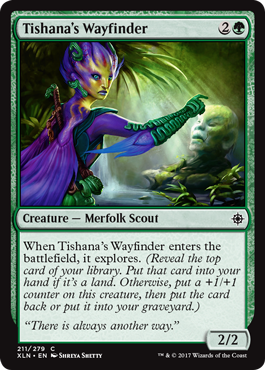
If a creature you control explores, you reveal the top card of your library. If the revealed card is a land, representing your creature finding some new territory you can check out, put that card into your hand. If it's not a land card, your creature comes back empty-handed (or empty-winged, empty-taloned, empty-pawed, etc.) but still benefits from the attempt. Specifically, you put a +1/+1 counter on it. Then, you decide whether the nonland card goes back on top of your library or into your graveyard.
Most creatures that explore, like Tishana's Wayfinder, do so because of an ability that triggers when they enter the battlefield. Creatures may also explore as a result of an activated ability. In either case, when that ability resolves, if the creature is no longer on the battlefield, it can still explore. If you reveal a land card, you'll still put it into your hand. If you reveal a nonland card, you won't put a +1/+1 counter on the now-absent creature, but you will decide whether the card goes back on your library or into the graveyard.
This set has a few cards with abilities that trigger whenever a creature you control explores. These abilities will trigger even if a creature leaves the battlefield and then explores as described above. There's lots to discover out there. Hop to it!
Ships Ahoy!
Vehicles make their return in Ixalan, ready to ferry your forces to victory.
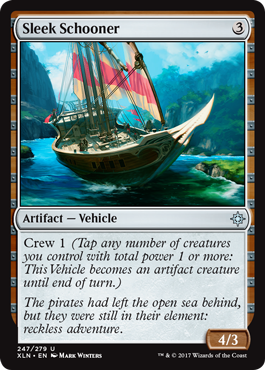
Nothing about how Vehicles work has changed since their last appearance. I wrote about Vehicles for the Kaladesh mechanics article, so I'll just quote myself with some minor edits:
Each Vehicle starts out as just an artifact. Well, an artifact with some potential. But they won't just get up and attack your opponent by themselves. Not even Kaladesh Ixalan has mastered the self-driving car Pirate ship yet. Each Vehicle has a crew ability that turns it into an artifact creature.
To activate the crew ability, tap any number of creatures you control with total power equal to or greater than the crew number. Because the crew ability doesn't use the tap symbol, you can tap any untapped creature you control, even one that just entered the battlefield. You can even tap an animated Vehicle to crew another Vehicle.
Discovering a Whole New . . . Face
Ixalan also marks the return of double-faced cards. But instead of showing a creature transforming into another version of itself, the double-faced cards of this set highlight the tales and tools of discovery.
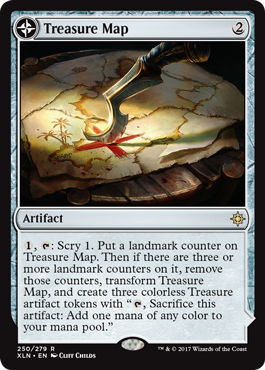
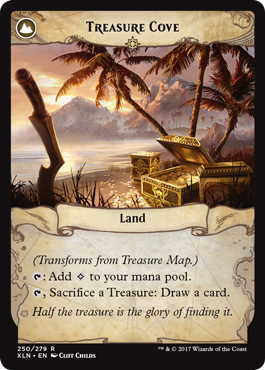
The rules governing double-faced cards remain unchanged for this set. If you knew how double-faced cards worked before, you're mostly ready for these new ones. One new twist, seen on Treasure Map/Treasure Cove, is that the back face is a land. Not only that, but a land with a gorgeous new map-inspired frame. Transforming a permanent into a land isn't the same as playing a land. Treasure Cove doesn't enter the battlefield, and it doesn't count as your land play for the turn.
Remember that transforming a tapped card to its other face doesn't untap it. So if you tap Treasure Map to activate its ability and it transforms, the Treasure Cove you find will be tapped. But all that Treasure!
If double-faced cards are new to you, here's a quick rundown: Each double-faced card has a front face. For all the Ixalan double-faced cards, this is the face with a compass icon in the upper left. This face is the default; the permanent starts on the battlefield with this face up. If an ability instructs you to transform the permanent, you turn it over so its other face is up. Whichever face is up tells you what that permanent is and what it can do.
You can't play any of the Ixalan double-faced cards with their back faces up. While a double faced-card isn't on the battlefield, it has only the characteristics of its front face. So, if a spell lets you search your library for a land card, you couldn't find Treasure Map/Treasure Cove. But if a spell let you search for an artifact card, you could.
Planeswalkers of Legend
(Editor's Note: This section has been updated to address Commander.)
Have you seen the planeswalkers in this set? Let's check out Jace!
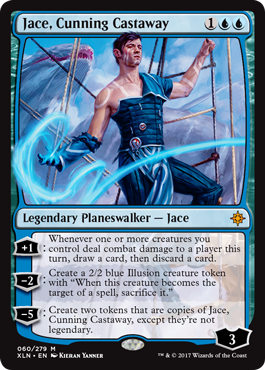
Well check out that fancy new type line! Legendary Planeswalker — Jace. You must have many questions. Let's pec away at them.
Starting with this set, all planeswalkers past, present, and future will have the supertype legendary. They will also be subject to the "legend rule." The "planeswalker uniqueness rule" is going away. What does this mean? In short, everything that's true about legendary permanents will now be true about legendary planeswalkers. Also note that this does not mean legendary planeswalkers can be your Commander unless an ability says so.
Under the new rules, if a player controls more than one legendary planeswalker with the same name, that player chooses one and puts the other into their owner's graveyard. This means that if you control Jace, Unraveler of Secrets and cast Jace, Cunning Castaway, both Jaces can exist under your control.
Planeswalkers will continue to have planeswalker types (Jace, Nissa, Bolas, and so on). However, those subtypes won't be used by any rule to determine what a player can retain control of. Cards like Jace's Defeat will continue to be able to refer to those subtypes.
Orazca Awaits!
Dinosaurs. Pirates. Merfolk. Vampires. Choose your traveling companions well, and the riches of Ixalan will be well within your grasp. Or just load up some friends and head to the Prerelease. Good luck!

